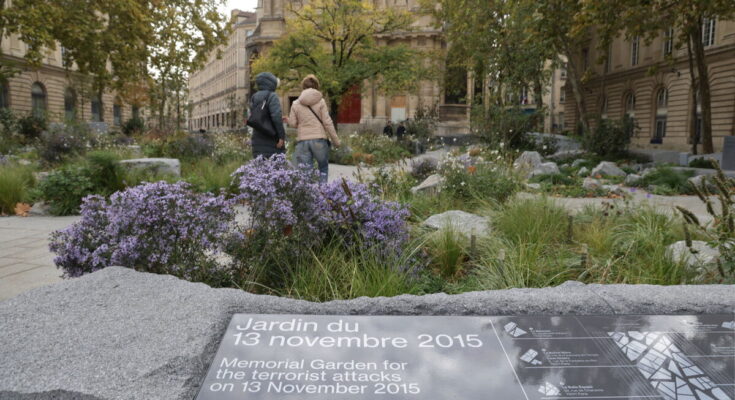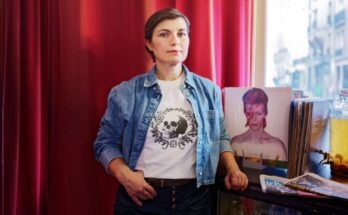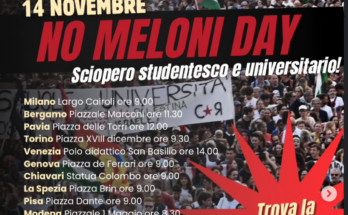Paris this Thursday marked the tenth anniversary of the attacks of November 13, 2015. After visiting each location of the attacks, the President of the Republic, Emmanuel Macron, had to continue his journey at 6 p.m. to the inauguration of the memorial garden at Place Saint-Gervais, near the City Hall (4). On this 3,500 m2 plant protection plot, which has been open to the public since June 20, every stone, every plant, every light tells a story. It was the night Paris turned upside down.
Mathieu Gontier, landscaper and co-founder of the agency Wagon Landscaping, carried out this unique project with heritage architects, memory historians and even lighting designers. “We are all concerned about this incident, that’s why we want to get involved,” he admitted. Several team members had relatives at the location of the attack. The others survived.
Mapping this tragic night
Everyone had the same “mental geography” on that night of horror. It was he who conceived the architecture of the gardens envisioned according to the plans of six assault venues: the Bataclan, the Stade de France, the Carillon terraces, the Petit Cambodge, La Belle Équipe, Comptoir Voltaire, La Bonne Bière and Casa Nostra.
Thus, the Stade de France is round and symbolic. The Bataclan was formed at its symbolic location. Marks of the places attacked are engraved on the outside of the stele, while inside, facing the heart of the park and its stone benches, the names of the 132 victims invite reflection.
Six blue granite steles from Lanhélin (Ille-et-Vilaine), emerging from a stone enclosure. This granite, which is a Parisian paving stone, was chosen together with the victims’ association. “Symbolically, it was also the land of Paris that was attacked that night,” underlines the landscaper. In the rear, a rock garden symbolizes the return of life from an inert environment. In the alleys, street names – boulevard Voltaire, rue Alibert – help you find your way.
The stars of November 13th are frozen in time
At night, the park is lit up by hundreds of fireflies that shimmer like candles. These points of light reproduce the sky of November 13, 2015, as if frozen in time. “We wanted the other 364 days of the year to be the night sky of November 13 lit up on the garden floor,” explains the designer.
The garden also hosts a “bird garden”, a concept developed with Gilles Clément, landscaper and major figure in ecological gardening in France. From bushes with edible berries to nest boxes in plane trees: everything has been designed to attract blackbirds, tits and robins. On the park’s opening day, a flock of titmice emerge from their nests and learn to fly. “It was a moment that showed that something powerful was happening here,” the landscaper recalls with emotion.
Behind each inscription, an ornamental apple tree offers red fruit that lasts all winter. Purple daisies bloom late in the season and, in early January, tulips appear, signaling spring. “It’s enough to offer colorful events all year round,” emphasizes Mathieu Gontier.
Two trees mark the threshold of the garden. On the side of the City Hall, an olive tree of peace, presented by the city government on the fifth anniversary of the attack and planted in the park in June. On the side of the church of Saint-Gervais, the elm of justice, a century-old heritage tree.
Musical common thread
Prior to its official opening, the park welcomed 250 survivors and victims’ families in June for four pre-opening days. Mathieu Gontier recalls a very symbolic and moving scene: a man who lost his wife in the attack was meditating on a bench. His current partner and his son were standing in the distance. The child was playing on the path, climbing rocks. “The little one approached his father and hugged him on this bench, facing the name of the missing woman,” said the landscaper. “This image brings together death, life and rebirth of a person who rebuilds himself. »
The official inauguration ceremony (this Thursday from 18.00 to 19.40) was led by the artistic direction of Thierry Reboul, conductor of the 2024 Olympics ceremonies. The common thread was music, a tribute to the “feeling of celebration” that the attacks sought to strike, culminating in a memorial service by Victor Le Masne. 1,800 people (associations, victims, families of the missing, etc.) will attend this tribute in person, also broadcast live on a giant screen installed on the Place de la République.



